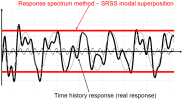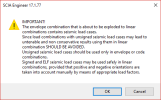Combinations containing seismic load cases
Particularities of seismic load cases
Many difficulties in the handling of seismic load cases come from one particularity:
Seismic load cases in general do not represent the state of the structure at a given time.
Seismic load cases represent the envelope of the assumed worst possible states of the structure during an earthquake.
As a matter of fact, the modal superposition methods applied in the response spectrum method (e.g. SRSS or CQC) are statistic methods that aim to estimate the envelope of the seismic response (red lines in the chart below) of any variable of the structural behaviour, without explicitly computing the time history response of the structure (black curve).
Time history response vs modal superposition envelope
The above statement leads to several consequences for seismic load cases:
- It is not possible to know the concomitant values of a result (e.g. bending moment My) in different sections of the structure (e.g. at a given time during an earthquake, the bending moment may be max in a section, while it is zero in another section and minimum in a 3rd section).
- It is not possible to know the relative sign of different results or results in different sections in the structure. This is a corollary of the previous consequence.
- It is not possible to know the concomitant values of different results in the same section. For instance, it is not possible to know what is the value of the normal force in a section when the bending moment is maximum in the same section, as peak values may occur at different times for the two components.
As a conservative assumption, seismic design is carried out using only extreme values of the envelope, basically assuming, that all results are extreme (min or max) at the same time. Please note, that that does not solve all problems: the critical situation could correspond to a case where one component is maximum while another is minimum (e.g. bending moment and normal force in the same section).
Left: Typical static wind load case, 1 set of values (bending moment in this case), no envelope
Right: Typical seismic load case, min and max envelopes, plus some possible, non-critical intermediate results
Types of seismic load cases
The sign concomitance issue can be solved in several ways. There are three possibilities in SCIA Engineer.
Unsigned dynamic seismic load case
The default settings of a seismic load case lead to this case. In order to carry out a safe design, each result must be considered as an envelope (min and max) and the worst case scenario must be considered for each section. For instance, for two internal forces components, it leads to 4 possible cases: min+min, min+max, max+min and max+max.
Specific settings for an unsigned, dynamic seismic load case
Signed dynamic seismic load case
This technique uses the sign of the results of one mode, deemed predominant. Those signs are applied to the envelope values, thus providing a reasonable assumption for the relative signs of all results.
Specific settings for a signed, dynamic seismic load case
Important: the predominant mode must be selected manually and be relevant for the considered results. The automatic selection available in SCIA Engineer works correctly only for 2D models (XZ plane structures).
The seismic load case then provides only one set of signed results. However, keep in mind, that the seismic action is cyclic and, therefore, must be applied in both directions to cover all cases. However, this solution reduces drastically the complexity, as only 2 cases remain to be checked. Because the relative signs of all results are known, it is sufficient to apply a plus or minus sign to the entire load cases at once.
ELF seismic load case
Equivalent lateral forces are used in an ELF seismic load cases, reducing it to a static load case. Of course, in such a case, there is no concomitance issue. However, the cycling nature of the seismic action remains to be considered, in the same way as for a signed dynamic seismic load case.
Sample settings for an ELF seismic load case
Load case combinations
Because a seismic load case is, in essence, an envelope, a basic rule could be, that a seismic load case must be used only in an envelope combination. However, thanks to the various available types of seismic load cases, there are exceptions, where using a seismic load case in a linear combination is possible. See the summary table below.
| A seismic load case of type... | has results... | and can be used in a... | ||
| linear combination | envelope combination | code combination | ||
| Dynamic unsigned | min/max envelope | NO | YES | YES |
| Dynamic signed | single set of signed values | YES | YES | YES |
| ELF | single set of signed values | YES | YES | YES |
A linear combination is a simple set of results. It has no envelope capability. Therefore, inserting an unsigned seismic load case, which is an envelope, into a linear combination, leads to an inconsistent situation, which can lead to unpredictable results.
Inserting an unsigned seismic load case into a linear combination just makes no sense!
When attempting to:
- switch to linear combination an envelope or code combination that contains an unsigned seismic load case
- explode to linear an envelope or code combination that contains an unsigned seismic load case
SCIA Engineer will display the following message (or similar, depending on the case), which reflects the recommendations above:
There are still, however, some possibilities that can end up having an unsigned seismic load case in a linear combination without triggering the message above, in particular when the project has been created in an older version of SCIA Engineer. Therefore, please be careful not to use unsigned seismic load cases in linear combinations.
Exploding seismic combinations
As described in the table above, not all use cases of seismic load case in a combination are meaningful. Exploding to linear an envelope combination or code combination that contains unsigned dynamic seismic load case(s) is incorrect.
Doing so gives a false sense of security by generating a list of linear combinations with alternating +1 and -1 coefficients for all seismic load cases, whence unsigned seismic load cases do not behave correctly in linear combinations. An unsigned seismic load case is an envelope per se, which cannot be handled correctly by a linear combination which is, by definition, not an envelope.
Never explode to linear a combination that contains unsigned seismic load cases.
Seismic code combinations
For more information about code-defined seismic combinations, see:







